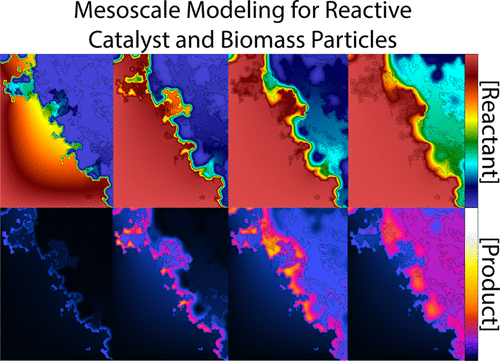当前位置:
X-MOL 学术
›
Energy Fuels
›
论文详情
Our official English website, www.x-mol.net, welcomes your feedback! (Note: you will need to create a separate account there.)
Bridging Scales in Bioenergy and Catalysis: A Review of Mesoscale Modeling Applications, Methods, and Future Directions
Energy & Fuels ( IF 5.3 ) Pub Date : 2021-08-31 , DOI: 10.1021/acs.energyfuels.1c02163 Peter N. Ciesielski 1 , M. Brennan Pecha 1 , Nicholas E. Thornburg 2 , Meagan F. Crowley 1 , Xi Gao 3 , Oluwafemi Oyedeji 4 , Hariswaran Sitaraman 5 , Nicholas Brunhart-Lupo 5
Energy & Fuels ( IF 5.3 ) Pub Date : 2021-08-31 , DOI: 10.1021/acs.energyfuels.1c02163 Peter N. Ciesielski 1 , M. Brennan Pecha 1 , Nicholas E. Thornburg 2 , Meagan F. Crowley 1 , Xi Gao 3 , Oluwafemi Oyedeji 4 , Hariswaran Sitaraman 5 , Nicholas Brunhart-Lupo 5
Affiliation

|
Between the molecular and reactor scales, which are familiar to the chemical engineering community, lies an intermediate regime, here termed the “mesoscale,” where transport phenomena and reaction kinetics compete on similar time scales. Bioenergy and catalytic processes offer particularly important examples of mesoscale phenomena owing to their multiphase nature and the complex, highly variable porosity characteristic of biomass and many structured catalysts. In this review, we overview applications and methods central to mesoscale modeling as they apply to reaction engineering of biomass conversion and catalytic processing. A brief historical perspective is offered to put recent advances in context. Applications of mesoscale modeling are described, and several specific examples from biomass pyrolysis and catalytic upgrading of bioderived intermediates are highlighted. Methods including reduced order modeling, finite element and finite volume approaches, geometry construction and import, and visualization of simulation results are described; in each category, recent advances, current limitations, and areas for future development are presented. Owing to improved access to high-performance computational resources, advances in algorithm development, and sustained interest in reaction engineering to sustainably meet societal needs, we conclude that a significant upsurge in mesoscale modeling capabilities is on the horizon that will accelerate design, deployment, and optimization of new bioenergy and catalytic technologies.
中文翻译:

生物能源和催化领域的桥梁尺度:中尺度建模应用、方法和未来方向的回顾
在化学工程界所熟悉的分子尺度和反应器尺度之间存在一个中间状态,这里称为“中尺度”,其中传输现象和反应动力学在相似的时间尺度上竞争。由于生物质和许多结构化催化剂的多相性质和复杂、高度可变的孔隙率特征,生物能源和催化过程提供了中尺度现象特别重要的例子。在这篇综述中,我们概述了中尺度建模的核心应用和方法,因为它们适用于生物质转化和催化加工的反应工程。提供了一个简短的历史视角,以将最近的进展置于背景中。描述了中尺度建模的应用,并强调了生物质热解和生物衍生中间体催化升级的几个具体例子。描述了包括降阶建模、有限元和有限体积方法、几何构造和导入以及模拟结果可视化在内的方法;在每个类别中,都介绍了最近的进展、当前的限制和未来发展的领域。由于对高性能计算资源的访问得到改善、算法开发的进步以及对可持续满足社会需求的反应工程的持续兴趣,我们得出结论,中尺度建模能力即将出现显着增长,这将加速设计、部署和优化新的生物能源和催化技术。描述了有限元和有限体积方法、几何构造和导入以及模拟结果的可视化;在每个类别中,都介绍了最近的进展、当前的限制和未来发展的领域。由于对高性能计算资源的访问得到改善、算法开发的进步以及对反应工程持续满足社会需求的持续兴趣,我们得出的结论是,中尺度建模能力即将出现显着增长,这将加速设计、部署和优化新的生物能源和催化技术。描述了有限元和有限体积方法、几何构造和导入以及模拟结果的可视化;在每个类别中,都介绍了最近的进展、当前的限制和未来发展的领域。由于对高性能计算资源的访问得到改善、算法开发的进步以及对反应工程持续满足社会需求的持续兴趣,我们得出的结论是,中尺度建模能力即将出现显着增长,这将加速设计、部署和优化新的生物能源和催化技术。
更新日期:2021-09-16
中文翻译:

生物能源和催化领域的桥梁尺度:中尺度建模应用、方法和未来方向的回顾
在化学工程界所熟悉的分子尺度和反应器尺度之间存在一个中间状态,这里称为“中尺度”,其中传输现象和反应动力学在相似的时间尺度上竞争。由于生物质和许多结构化催化剂的多相性质和复杂、高度可变的孔隙率特征,生物能源和催化过程提供了中尺度现象特别重要的例子。在这篇综述中,我们概述了中尺度建模的核心应用和方法,因为它们适用于生物质转化和催化加工的反应工程。提供了一个简短的历史视角,以将最近的进展置于背景中。描述了中尺度建模的应用,并强调了生物质热解和生物衍生中间体催化升级的几个具体例子。描述了包括降阶建模、有限元和有限体积方法、几何构造和导入以及模拟结果可视化在内的方法;在每个类别中,都介绍了最近的进展、当前的限制和未来发展的领域。由于对高性能计算资源的访问得到改善、算法开发的进步以及对可持续满足社会需求的反应工程的持续兴趣,我们得出结论,中尺度建模能力即将出现显着增长,这将加速设计、部署和优化新的生物能源和催化技术。描述了有限元和有限体积方法、几何构造和导入以及模拟结果的可视化;在每个类别中,都介绍了最近的进展、当前的限制和未来发展的领域。由于对高性能计算资源的访问得到改善、算法开发的进步以及对反应工程持续满足社会需求的持续兴趣,我们得出的结论是,中尺度建模能力即将出现显着增长,这将加速设计、部署和优化新的生物能源和催化技术。描述了有限元和有限体积方法、几何构造和导入以及模拟结果的可视化;在每个类别中,都介绍了最近的进展、当前的限制和未来发展的领域。由于对高性能计算资源的访问得到改善、算法开发的进步以及对反应工程持续满足社会需求的持续兴趣,我们得出的结论是,中尺度建模能力即将出现显着增长,这将加速设计、部署和优化新的生物能源和催化技术。



























 京公网安备 11010802027423号
京公网安备 11010802027423号